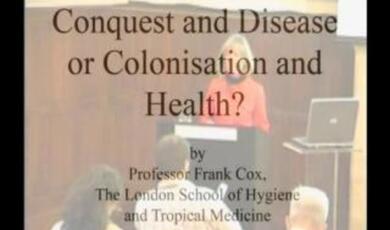Front line infectious disease control at Britain's borders
Share
- Details
- Transcript
- Audio
- Downloads
- Extra Reading
John Averns, Port Health Director, London Port Health Authority. The series ended with a lecture bringing us up-to-date with the current work carried out by the Corporation of London's Port Health Authority in the prevention of disease entering the country.
Download Transcript
Frontline Infectious Disease Control at Britain’s borders
Jon Averns, Port Health Director, City of London
Introduction
Infectious diseases represent a major health problem in both developed and developing countries. Worldwide, infectious diseases account for about one-third of all deaths (46% of deaths in developing countries). There have been demands worldwide to fortify public health systems in consequence of increasing problems in infectious disease caused by a range of novel and resurgent microbes, particularly Severe Acute Respiratory Syndrome (SARS) but also, for example Tuberculosis, AIDS, Ebola virus and other haemorrhagic diseases. The impact of increasing international travel and world trade in agriculture, as well as the threat from bioterrorism, poses a huge threat to the public and animal health of Britain as well as its economy.
People and goods are crossing national borders in massive numbers unparalleled in human history. In the past, measures such as quarantine and trade embargoes were employed to prevent the importation of infectious diseases. The ultimate way to prevent international spread of disease would be to stop all international trade, travel and tourism but clearly this is completely impracticable and economically unacceptable.
This paper examines the legislation, methods, and practical measures employed to control infectious disease at Britain’s borders. Particular emphasis is placed on London, and future legislation and challenges are also examined.
Historical aspects of controls
One of the earliest recorded incidents of the spread of disease by sea transport occurred during the winter of 1346/47 when a small band of Genoese traders took shelter at Caffa (now Theodosia) on the Black Sea. The town was besieged by attacking Tartars, many of whom were infected by the plague or “Black Death” as it later became known. On returning to Genoa these seamen brought with them the deadly disease which rapidly spread through Northern Europe to arrive in England at the port of Melcombe (now part of Weymouth ) on the Dorset coast in June 1348 from where it quickly spread to other parts of Britain.
It is understood that one of the earliest forms of “quarantine” occurred in 1374 when the Venetian republic ordered the inspection of incoming vessels, and the exclusion of infected ships. This successful operation was extended to other ports and three years later the town of Ragusa (now Dubrovnik ) introduced a system of isolating ships coming from countries where plague was endemic. Infected persons were detained for thirty days before entering the gates and the port authorities in Marseille introduced similar measures. In 1383, the period was extended to forty days or (quarantenaria) became established later as the usual period of isolation for seaborne travellers and goods suspected of harbouring infectious diseases. By 1448, the Venetian authorities had established a complete code of quarantine regulations.
From the very outset, quarantine of seagoing vessels as well as the passengers and crew was regarded with hostility by merchants. Quarantine measures were regarded as detrimental to the interests of international commerce. The fact that the causes of infectious diseases were not known also did not help. Those who upheld the Miasma theory claimed that the disease came from a poisonous atmosphere or bad air in relation to climate and soil, and during the Victorian era this theory was widely held. According to the theory, air became infused with epidemic influence under certain conditions. When this air combined with decomposing materials, the resulting gases, called miasms, caused disease. This theory seemed to explain why diseases were prevalent in areas with poor sanitation. The general rule was that miasms could be recognized as bad smells and people could reduce the risk of disease by eliminating the sources of bad smells. Indeed, Malaria derives its name from ‘mala aria’ or bad air.
Though completely inaccurate, the theory of miasma did produce some beneficial results. For example, opening windows and exposing sick rooms to the sun, clearing away garbage, refuse, decomposing corpses, and washing away sewage were likely to result in a healthier environment. Florence Nightingale, the founder of modern day nursing, was able to dramatically reduce deaths among soldiers during the Crimean War by instituting rigorous hygiene requirements meant to eliminate miasmas. Unfortunately, among the population at large, the miasma theory often resulted in actions such as washing sewage into sources of drinking water in order to eliminate the bad smell.
The “Contagionists” claimed that disease was conveyed by direct or indirect contact and that the solution lay in isolation and quarantine, and gradually it became apparent that they were correct, together with the germ theory that followed via Louis Pasteur.
In England, the first of several orders in counsel was enacted in 1709 for what was to be a continuous quarantine policy placing a quarantine on all ships and persons from infected areas to be performed in prescribed places. Beginning 10 October 1806, the signal from an infected vessel had to be a yellow and black flag by day and by night two lanterns, one above the other. It was not until 1811 that the death penalty was abolished as a sentence for quarantine offences.
The spread of Cholera to Great Britain prompted the General Board of Health to produce a report on quarantine. It was decidedly anti Contagionist, and led to the First International Sanitary Conference in 1851, although the resulting convention was ratified by only France and Sardinia. The British view was that the enforced detention of ships in quarantine was only necessary when the disease was actually on board, and that if the ship was in a foul condition it should be cleansed and disinfected before free pratique (permission to enter a port, embark or disembark, discharge or load cargo) was granted. Varying arrangements were introduced to try and cope with the introduction of Cholera via vessels but these proved unsatisfactory.
The Registrar General’s report for the quarter ending December 1865 comments
“the importance of attention to the hygienic conditions of both our merchant vessels and our seaports is clearly seen; for a foul ship, instead of merchandise, carries from land to land the seed of depopulatory diseases, and a foul seaport supplies soil in which they readily germinate”.
The Public Health Act of 1872 empowered the Local Government Board to constitute one port sanitary authority with jurisdiction over the district of any port established by the Commissioner of Customs. They were charged with taking proper steps, under orders in counsel, to prevent the introduction of Cholera and other quarantinable diseases, and to enforce related legislation at improving sanitary conditions aboard vessels in ports. The City of London Corporation undertook this responsibility for the Port of London. The district covered by the City includes the whole of the Tidal Thames from Teddington Lock in the west for a distance of ninety four miles out of the Thames Estuary and includes the lower course of the River Medway.
Dr Harry Leach, the first Medical Officer of Health for the Port of London, wrote in 1873
“it is acknowledged that as a natural result of the insular position of the kingdom and the vast extent of our commerce, the sanitary conditions of shipping and of the floating population must exercise a considerable influence on the health of the country as regards the importation and transmission of epidemic diseases”.
Quarantine continued until 1889 when the Infectious Disease Prevention Act was introduced which made regulations to deal with Cholera, Yellow Fever and Plague as well as introducing medical inspection aboard vessels to replace quarantine. Thereafter, vessels arriving from a foreign port, other than most European ports which became exempt, were subject to inspection by a boarding medical officer or port health inspector.
The Port of London Sanitary Authority, now the London Port Health Authority, based its operations at Gravesend where a hulk, the “Hygeia” was maintained as a quarantine station where accommodation was provided for the boarding medical officers who provided a service twenty four hours a day. Various quarantine launches were at the medical officers’ disposal, including, for example, the Humphrey Morris which was acquired in 1962 and had a consultation room, a small hospital with accommodation for two stretcher cases and three sitting patients. Up until 1978 the Port Health Authority’s team of doctors screened all vessels entering the Port of London and decided which ones should be boarded. In fact, all ships coming from areas known to have certain endemic diseases, such as Africa, Asia, Central and South America were boarded.
In order to carry out these health checks, the Port Health Authority had to have accurate information on shipping. Therefore, all ships masters were required to radio ahead, giving the Authority at least four hours notice of their arrival, so that the authority had time to check where they had been and to make any necessary preparations. There are many accounts of different infectious diseases in the annual reports produced by the Medical Officer of Health for the Port Health Authority. These range from Malaria to Smallpox, and interestingly the 1957 report refers extensively to Asian Influenza and the arrangements being made to deal with the potential introduction of the disease via the port. One report refers to the SS Arcadia, a cruise ship, that had 176 out of its crew of 725 affected. Complete disinfection of all the accommodation had to be carried out and control measures were introduced to prevent further spread amongst other crew.
Current portal controls
In 1948, the World Health Organisation constitution came into force and in 1951 Member States adopted the International Sanitary Regulations, which, following successive international sanitary conferences, were replaced by and renamed the International Health Regulations in 1969. They were originally intended to monitor and control six serious infectious diseases: Cholera, Plague, Yellow Fever, Smallpox, Relapsing Fever and Typhus. Under the current Regulations, only Cholera, Plague and Yellow Fever are notifiable, meaning that States are required to notify WHO if and when these diseases occur on their territory. The Regulations specified the maximum restrictions that could be applied to ships and aircraft involved in international commerce
They are based on the assumption that the only effective protection against the spread of epidemics is in the provision of wholesome supplies of food and water, the effective disposal of waste, and the elimination of vectors of disease on ships and aircraft. Following the increasing emphasis on epidemiological surveillance for communicable disease recognition and control, the WHO agreed to strengthen the use of epidemiological principles as applied internationally, to detect, reduce or eliminate the sources from which infection spreads, to improve sanitation in and around ports and airports, to prevent dissemination of vectors and in general to encourage epidemiological activities on the national level, so that there is little risk of outside infection establishing itself.
As a result of a worldwide campaign by WHO, Smallpox was eradicated and vaccination against the disease is no longer required. Efforts to control Cholera by vaccination failed to prevent the spread of the disease, and people arriving from infected areas are no longer required to have Cholera vaccinations. Yellow Fever and Plague are controlled by measures to control the vectors of the disease. A Yellow Fever vaccination is required for people arriving in countries where the mosquito vector of the disease is prevalent, but this does not include the United Kingdom. Following the change in the approach to dealing with Cholera and the elimination of Smallpox, the International Health Regulations were amended in 1973 and 1981.
Provision is made in the United Kingdom for implementing the government’s obligations under these regulations in the Public Health (Ships) Regulations 1979 and Public Health (Aircraft) Regulations 1979. There are also the Public Health (International Trains) Regulations 1994.
In practice these regulations provide for people arriving on infected or suspected ships or aircraft to be placed under surveillance and the periods are calculated from the time of leaving the infected area. Measures to control the spread of Lassa Fever, Rabies, Viral Haemorrhagic Fever and Marburg Disease are also specified. An infected ship or aircraft is one that has a case of the above diseases on board or where a plague infected rodent is found on arrival. Suspected ships or aircraft include those that have left infected areas or have had a case of a notifiable disease on board at some point prior to arrival.
The master of a ship or the commander of an aircraft arriving from a foreign country must report to the port health authority if there has been a death on board other than by accident or where there are any infectious diseases or symptoms of infectious disease such as rash, temperature, glandular swelling, jaundice or diarrhoea severe enough to interfere with work or normal activities. Animals and birds must be reported together with any other circumstances that are likely to cause the spread of infectious disease. A maritime declaration of health form must be completed by the master and presented to the Boarding Medical Officer.
If none of these circumstances prevails, the ship or aircraft does not require health clearance (free pratique) unless otherwise directed by an authorised officer of the port health authority. The measures employed to prevent the spread of infectious disease from ships or aircraft that are suspected or infected or which have arrived from an infected area, include the treatment of any person suffering from or exposed to infectious disease, disinfection or disinsection of ships, aircraft or clothing. Precautions are also adopted to prevent the escape of plague infected rodents and the removal of any contaminated food or water other than the cargo.
London Port Health Authority employs its own Consultant in Communicable Disease Control together with her team who are available around the clock to advise on any problems, board ships or aircraft and implement control plans and emergency procedures. Equally, there is a 24/7 availability of port health inspectors, who are all qualified environmental health officers capable of inspecting vessels and aircraft, and arranging for treatment where necessary. The use of a hulk in Gravesend Reach has long been discontinued, but the authority’s office is still to be found in the allegedly haunted former quarantine station at Gravesend. The authority still has two fifty foot launches and three rigid inflatable boats (RIBS). These are deployed when necessary to transport boarding medical officers to ships at anchorage or to meet the arriving vessel. The crews are highly trained first aiders and are capable of using resuscitation apparatus.
All vessels arriving from a foreign port must have a Deratting Certificate issued in a designated approved port showing that the ship has been deratted within the previous six months, or an Exemption Certificate that indicates it is free from rodents. If the certificate was issued more than six months previously, the ship must be inspected at an approved port and, if necessary, be treated to control the rodents or another Exemption Certificate issued. The inspection of the vessel involves examination of all areas, but particularly the galley and food storage areas. The intention of this requirement is to eliminate rodents and thus the plague vector from ships.
In order to minimise the risk of aircraft spreading vectors of disease, disinsection using an approved aerosol dispensers may be undertaken on arrival from an infected area.
Parallel controls
The measures referred to above for the control of infectious disease are in circumstances where the master or the commander identifies reasons to notify the port health authority of infectious disease or suspected infectious disease. However, additional screening is also carried out at airports under the 1971 Immigration Act which provides the statutory basis for the medical examination of passengers wishing to enter the UK. Immigration officers have the power to refer any individual who is subject to immigration control to a doctor for a medical examination at the port of entry. The current policy is to refer for medical examination any person who intends to remain in the United Kingdom for more than six months, or who mentions health or medical treatment as a reason for his visit or who appears not to be in good mental or physical health or comes from an area of the world where there is a high risk for Tuberculosis. Where a health problem is identified, a medical inspector can pass information (eg test results) to the district to which an entrant is heading so that appropriate treatment may be offered. There is considerable debate as to whether there should be compulsory screening of asylum seekers to the UK and pre entry checks for migrants. No firm decision seems to have been reached despite a number of reports on this contentious issue.
Risks to public and animal health can also be conveyed via live animals and products of animal origin. Consequently, to protect animal and public health, even prior to Britain’s entry into the EU, legislation was in place to control imported foods and animals. There is now a raft of harmonised European legislation, some of it only introduced as recently as January this year that controls the importation of foodstuffs, particularly products of animal origin, imported from countries outside the European Union. Products of animal origin can only be imported through European Commission approved ports known as Border Inspection Posts that must have proper inspection facilities as well as Official Veterinarians and Fish Inspectors. London Port Health Authority has two such ports at Tilbury and Thamesport, on the Isle of Grain in Kent. Both of these are container ports and handle most of the red meat entering the United Kingdom, some 350,000 tonnes. Every consignment undergoes some form of check, whether it is only a documentary check on the health certification that accompanies the consignment or a full physical check involving analytical tests. Containers may be detained at the port until results are known and if necessary rejected or destroyed.
Following the last Foot and Mouth disease epidemic, there was considerable government concern over the potential animal health threat from smuggled goods such as bushmeat, which was entering the country in large quantities, mainly via passenger baggage at airports. Her Majesty’s Revenue & Customs were given the responsibility of detecting such goods and they now employ anti smuggling teams, including sniffer dogs, to detect these products. Live animals also pose a risk and although the Passport for Pets scheme has been introduced for some origins, the City of London Corporation still runs the Animal Reception Centre at Heathrow which is a Border Inspection Post for live animals as well as being a holding area for any animals in transit or those that need to go into quarantine.
Another activity undertaken by Port Health Authorities is water sampling at seaports and airports to ensure that supplies are potable and also that water actually aboard vessels and aircraft that has been taken on in other ports is safe and wholesome. There is a guide are nationally agreed standards, as problems are still being experienced with faecal contamination in water supplies leading to potential public health risk.
There are, therefore, a range of complementary activities undertaken by port health services to prevent the spread of infectious diseases and zoonoses, and these are constantly being revised and updated to meet emerging threats.
Future controls and challenges
As mentioned above, the current International Health Regulations date from 1969 and i n the early 1990s, the resurgence of some well known epidemics such as Cholera in parts of South America, Plague in India and the emergence of new infectious agents such as Ebola Haemorrhagic Fever resulted in a resolution at the 48th World Health Assembly in 1995 calling for the revision of the Regulations.
Subsequently, the World Health Organisation undertook a lengthy revision process between 1995 and 2005. It was recognised that the current regulations need to be extended to cover currently unknown or unforeseeable public health threats, and that only having the ability to respond to diseases that were already identified as being caused by infectious agents was extremely limited. Notifications of infectious diseases are wholly dependent on the affected country to make an official notification to the World Health Organisation once cases are diagnosed. There is also little mechanism for collaboration between WHO and a country in which infectious diseases, with a potential for international spread, are occurring. There is an absence of incentives to encourage compliance by member states, and WHO lacks the capacity to prescribe specific measures, tailored to the actual threat posed by an outbreak, that will prevent spread of the disease on a global basis.
Consequently, in May 2005, a revised version of the International Health Regulations was adopted by the 58th World Health Assembly. The new version broadens the scope of the regulations and defines disease as “an illness or medical condition, irrespective of origin or source, that presents or could present, significant harm to humans”. This means that chemical, biological, or radiological or nuclear events can be included in the scope of the regulations as well. The broadened purpose of the new regulations is to prevent, protect against, control and provide a public health response to the international spread of disease which avoids unnecessary interference with international traffic and trade.
The renewed mandate given to Member States and WHO under the Regulations has also increased their respective roles and responsibilities. In particular, countries are required to develop, strengthen and maintain core surveillance and response capacities to detect, assess, notify and report public health events to WHO and respond to public health risks and public health emergencies. WHO, in turn, is to collaborate with States Parties to evaluate their public health capacities, facilitate technical cooperation, logistical support and the mobilization of financial resources for building capacity in surveillance and response.
The new regulations need to be adopted by member states by June 2007 and the Department of Health has recently commenced negotiation with the Association of Port Health Authorities about the way in which the regulations will be transposed into UK legislation. Some of the requirements are very similar to the current regulations but the notifiable diseases have been changed to include Smallpox, Polio, New Human Influenza and SARS. A decision tree is deployed to determine whether other diseases and events are an event for potential international emergency of public health concern, in which case the World Health Organisation must be informed. An international public health emergency of public health concern is defined as an extraordinary event which is determined:
to constitute a public health risk to other states through the international spread of disease and to potentially require a coordinated international response.
On the practical side, Deratting certificates are replaced by Ships Sanitation certificates which greatly expand the areas for public health inspections on international ships. Port health officers inspecting ships for certificates will have to note all on board sanitation problems that could lead to international disease spread, as well as identifying the measures required to eliminate or reduce the risk.
It should be noted that the new regulations include New Human Influenza, and currently Avian Influenza is the topic of much discussion and planning in the event that the virus mutates to a form that is transmissible between humans. In London we are already making contingency arrangements in preparation for the possible human to human transmission and introduction to the UK via our ports. The Health Protection Agency has its own pandemic contingency plan but unfortunately the UK is well overdue an influenza epidemic, and realistically, it is unlikely that the condition will be contained via the ports.
There are continuing threats from longstanding the well known diseases such as Malaria, Cholera, Typhoid and Tuberculosis, but the emergence of different types of Hepatitis, SARS and Viral Haemorrhagic fevers means that risk assessments and contingency planning arrangements must constantly be reviewed.
There is a focus now on all chemical, radiological and nuclear incidents that could be a result of bioterrorism. The Civil Contingencies Act requires all relevant agencies and organisations to prepare and plan for all types of incidents, so that responses can be achieved in a coordinated an organised manner.
Conclusion
The prevention of the spread of infectious disease between nations has been a preoccupation of government since the earliest times, particularly with island communities such as our own. There is growing incidence of antibacterial and antiviral resistance and vaccination strategies may fail because of high costs for developing countries, public resistance in some EU countries and antigenic variations of micro organisms, especially viruses. Consequently there is still the need for effective border controls and controls aboard ships and aircraft to prevent the spread of disease. The new International Health Regulations should go some way to improving the position, and it is interesting to note that on 26 January this year the World Health Organisation executive board adopted a resolution calling upon member states to comply immediately with the new regulations on a voluntary basis bearing in mind the risk posed by Avian and pandemic Influenza. Only time will tell as to whether the controls implemented were adequate and timely.
© Jon Averns, Gresham College, 3 March 2006
This event was on Mon, 03 Apr 2006
Support Gresham
Gresham College has offered an outstanding education to the public free of charge for over 400 years. Today, Gresham plays an important role in fostering a love of learning and a greater understanding of ourselves and the world around us. Your donation will help to widen our reach and to broaden our audience, allowing more people to benefit from a high-quality education from some of the brightest minds.


 Login
Login







